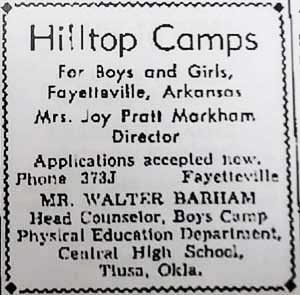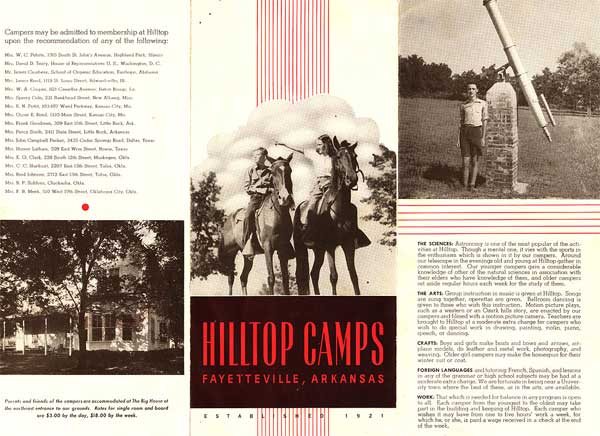Pratt Place-Markham Camp
|
Community Radio show aired on KPSQ 97.3 FM: |
Extracted from 1999 write up on the 1921-1941 camp listed in Arkansas Register of Historic Places.
Pratt Place-Markham Camp located on a wooded hilltop west of the University of Arkansas, Fayetteville campus, is a respite from the busy roads and congested campus below. The area served as agricultural land in the late nineteenth-century and as the Pratt family home and Markham Summer Camp for boys and girls from 1900 to 1941. Today it is home to several families and student renters, but it has managed to retain its secluded environment. Pratt Place, constructed in 1895, has suffered few alterations and displays most of its original facade and surroundings, evincing the atmosphere of early Fayetteville. The Twin Cabins southeast of Pratt Place are the only shelters remaining from the Markham Camp that have not been recognizably altered by renters in recent years.

Hilltop Camps newspaper ad
The city of Fayetteville in northwest Arkansas was forged from Arkansas Territory that had formerly been earmarked for Native-American habitation. By the 1820s there was mounting pressure to allow white settlement, so by 1827 the Secretary of War consented to white settlement, pushing resident Cherokees to the west.
After the Civil War Fayetteville grew quickly, growth that was augmented by the establishment of the State University and the St. Louis and San Francisco Railroad. It was during this period that Pratt Place was constructed. The sizable house was built in 1895 on a wooded hill west of the University of Arkansas, Fayetteville. Cassius Lot Pratt who had been a rancher, teacher and county judge in Texas, retired in 1890 to Springdale. In 1900 he bought the home and a forty-acre tract in Fayetteville from the original owner who had run low on funds and was unable to finish construction. The Pratts completed the home and moved in with their family of four boys and two girls.
The Pratt children were all early graduates of the University of Arkansas. In 1920 after the eldest daughter, Joy, completed her education at the Chicago Art Institute she was married to Hogan Markham, a science teacher from Chicago. In 1921 the couple established a coeducational summer camp on the hilltop where her family home stood in Fayetteville. The camp was known by several names over the years including, Camp Keetoosa, Camp Markham, Hilltop Camps and Markham Camps. The amenities offered boys and girls "from childhood to young manhood and womanhood" by the camp included; horseback riding, swimming, tennis, archery, camping trips, the sciences, the arts, crafts, foreign languages and work. The camping season spanned eight weeks during July and August. When the summer season ended the Markhams ran the Phoenix Country Day and Boarding School in Phoenix, Arizona.
The campgrounds covered forty-six acres, with a camp for boys in a western meadow and a camp for girls in an eastern meadow. Both areas had their own playgrounds, assembly house, kitchen, dining room and shower baths and the twain came together only on arranged occasions. Other structures on the campgrounds were a dining hall, a recreation hall, nine residential camp cabins and swimming pool. The Pratt House was utilized as camp headquarters, bakery, boarding house for visiting parents, craft area and hot bathhouse for girls.
Lodging for older boys was in a tent field near the swimming pool. The girls and younger boys lived in shacks, six campers and one leader to a shack. The shacks were constructed of wood with half-walls and curtains. Boys could stay in a floored tent by themselves with a leader's tent nearby. A 1928 camp brochure outlined the dress code as such; camp uniforms for boys were blue and tan; girls wore scarlet and tan. "Camp costumes" for boys were khaki shorts or knickers and shirt with blue bandana and sweater. The girls wore khaki shorts or bloomers and shirt with scarlet bandanas and sweater. For riding, the boys wore blue levis and the girls black levis. Dress costume for girls consisted of a pongee shirt and light shorts or knickers. Most of the time the boys wore athletic shirts or none at all, "receiving the direct benefit of the sun upon their bodies." Campers were required to bring sheets, blankets, towels, pillowcases, pillow, poncho, and cooking kit and canteen.
The camp served hundreds of young people from the midwestern and southern states, as well as Arizona, California and Washington DC. Markham Camp maintained an association of representatives in those states to encourage annual enrollment. During the Depression the Markhams curtailed operations and offered day camp only until 1941 when they shut down. In the 1950s the remaining camp shacks were winterized through the addition of windows and were rented out to students. Joy Markham continued to live at Pratt Place until her death in 1976. Joy and her sister Evangeline who also lived on the hill, worked together to keep the major portion of the camp site free from the type of uncontrolled development that can be seen in Fayetteville today.
The area that encompassed the Markham Camp and Pratt Place since 1895 has remained largely unchanged due to the efforts of the Pratts and their descendants. Visitors to the hilltop today would not have to use much imagination to picture the environment that the campers lived in during their summer occupancy or the vista that greeted the Pratts when they moved to the area in 1900. The Plain/Traditional and Italianate and Rustic architecture of the buildings used in daily operations at Markham Camp have been slightly altered through the years, and though they are evocative of the Camp era those changes qualify them for nomination to the Arkansas Register rather than National Register.
Bibliography
Brochure for Hilltop Camps, Fayetteville, Arkansas. Undated.
Brochure for the Markham Camps for boys and girls. 1928.
Leflar, Robert A. The First 100 Years Centennial History of the University of Arkansas. Fayetteville, AR: University of Arkansas Foundation Inc., 1972. Pp. 257-72.
National Register nomination form on file at Arkansas Historic Preservation Program for Pratt-Markham House and property. 1977.
Waterman-Pratt-Archer, Julian. The Story of Sassafras Hill and Haskell Heights.
